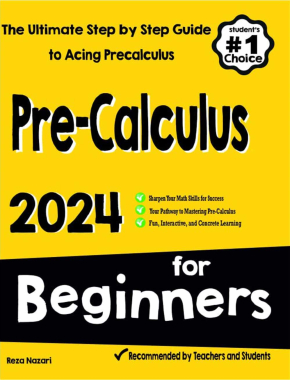The Ultimate Precalculus Course (+FREE Worksheets & Tests)
[include_netrun_products_block from-products="product/ged-math-test-prep-in-30-days-complete-study-guide-and-test-tutor-for-ged-mathematics-the-ultimate-book-for-beginners-and-pros-two-practice-tests/" product-list-class="bundle-products float-left" product-item-class="float-left" product-item-image-container-class="p-0 float-left" product-item-image-container-size="col-2" product-item-image-container-custom-style="" product-item-container-size="" product-item-add-to-cart-class="btn-accent btn-purchase-ajax" product-item-button-custom-url="{{url}}/?ajax-add-to-cart={{id}}" product-item-button-custom-url-if-not-salable="{{productUrl}} product-item-container-class="" product-item-element-order="image,title,purchase,price" product-item-title-size="" product-item-title-wrapper-size="col-10" product-item-title-tag="h3" product-item-title-class="mt-0" product-item-title-wrapper-class="float-left pr-0" product-item-price-size="" product-item-purchase-size="" product-item-purchase-wrapper-size="" product-item-price-wrapper-class="pr-0 float-left" product-item-price-wrapper-size="col-10" product-item-read-more-text="" product-item-add-to-cart-text="" product-item-add-to-cart-custom-attribute="title='Purchase this book with single click'" product-item-thumbnail-size="290-380" show-details="false" show-excerpt="false" paginate="false" lazy-load="true"]

Embark on a transformative journey through the realm of numbers and equations with our comprehensive online Precalculus course. This meticulously crafted program is tailored to empower learners with a robust mathematical foundation, meticulously covering the breadth of Precalculus topics.
Our premier Precalculus course emerges as your quintessential academic partner, steering you toward scholastic triumph.
Annually, innumerable scholars incorporate this Precalculus course with the suite of resources provided by Effortless Math Education. They leverage these assets to refine their mathematical acumen, enhance conceptual understanding, discern personal academic strengths and areas for improvement, and ultimately reach the zenith of their Precalculus potential.
This course redefines the learning experience, liberating you from the confines of rigid timetables. Each tutorial is intricately constructed, comprising informative notes, illustrative examples, ample practice exercises, and a spectrum of engaging activities to ensure absolute conceptual mastery is achieved with unparalleled simplicity and precision.
Precalculus Complete Course
Real Numbers and Relation
- Real Numbers
- Real Numbers Line
- Coordinate Plane
- Relation
- Showing the relation in the coordinate plane
- Domain and Range of Relation
- Functions
- Identifying the function from the graph
- Graphs of Basic Functions
Vectors in Two Dimension
- Introduction to Vectors: Vectors in Two Dimensions
- Equality of Vectors in Two Dimensions
- Scalar Multiplication
- Vector addition and subtraction
- Representation of Addition and Subtraction
- Length of a Vector
- Dot Product and Cross Product
- Parallel vectors
- Orthogonal Vectors
- Parametric Equations and Graphs
- Applications of Vectors
Equations and Inequalities
- Solving Multi-Step Equations
- Slope and Intercepts
- Using Intercepts
- Transforming Linear Functions
- Solving Inequalities
- Graphing Linear Inequalities
- Solving Compound Inequalities
- Solving Absolute Value Equations
- Solving Absolute Value Inequalities
- Graphing Absolute Value Inequalities
- Solving Systems of Equations
- Solving Special Systems
- Systems of Equations Word Problems
Functions
- Evaluating Functions: Function Notation
- Modeling Real-world Situations with Functions
- Adding and Subtracting Functions
- Multiplying and Dividing Functions
- Composite Functions
- Real Zeros
- Average Rate of Changes
- Codomain
Polynomial and Rational Functions
- The Simplest Functions: Constant and Identity
- Polynomial Functions
- Graphing Polynomial Functions
- Writing Polynomials in Standard Form
- Simplifying Polynomials
- Factoring Trinomials
- Solving a Quadratic Equation
- Graphing Quadratic Functions
- Solving Quadratic Inequalities
- Graphing Quadratic Inequalities
- Rational Equations
- Multiplying and Dividing Rational Expressions
- Simplifying Rational Expressions
- Rational Functions
- Graphing Rational Expressions
Exponential Functions and Logarithms
- Exponential Functions: Definition and Properties
- Solving Exponential Equations
- Logarithmic Functions: Definition and Properties
- Evaluating Logarithms
- Properties of Logarithms
- Natural Logarithms
- Solving Logarithmic Equations
Radical and absolute value Functions
- Simplifying Radical Expressions
- Simplifying Radical Expressions Involving Fractions
- Adding and Subtracting Radical Expressions
- Multiplying Radical Expressions
- Radical Equations
- Solving Radical Inequalities
- Domain and Range of Radical Functions
- Graphing Radical Functions
- Absolute Value Functions
- Graphing Absolute Value Functions
- Absolute Value Properties
- Floor Value
- Floor Function
- Graphing Floor Function
Functions Operations
- Positive, Negative, Increasing and Decreasing Functions on Intervals
- Transformations of Functions
- Function Symmetry: Even and Odd
- End Behavior of Polynomial Functions
- One-to-One Function
- Identifying the function one by one from the graph
- Onto (Surjective) Functions
- Function Inverses
- Inverse Function Graph
- Inverse Variation
- Piecewise-defined Functions
Trigonometry
- Degrees, Radians, and Angle Conversions
- Coterminal and Reference Angles
- Angles of Rotation and Unit Circle
- Arc length and Sector Area
- Sine, Cosine, and Tangent
- Reciprocal Functions: Cosecant, Secant, and Cotangent
- Domain and Range of Trigonometric Functions
- Arcsine, Arccosine, and Arctangent
- Applications of Inverse Trigonometric Function
- Fundamental Trigonometric Identities
- Pythagorean Trigonometric Identities
- Co-Function, Even-Odd, and Periodicity Identities
- Double Angle and Half-Angle Formulas
- Sum and Difference Formulas
- Product-to-Sum and Sum-to-Product Formulas
Trigonometric Functions and Graphs
- Graph of the Sine Function
- Graph of the Cosine Function
- Amplitude, Period, and Phase Shift
- Writing the Equation of a Sine Graph
- Writing the Equation of a Cosine Graph
- Graph of the Tangent Function
- Graph of the Cosecant Function
- Graph of the Secant Function
- Graph of the Cotangent Function
- Graph of Inverse of the Sine Function
- Graph of Inverse of the Cosine Function
- Graph of Inverse of the Tangent Function
- Sketching Trigonometric Graphs
Trigonometric Equations
- Basic Techniques for Solving Trigonometric Equations
- Factoring and Simplifying Trigonometric Expressions
- Solving Equations with Multiple Angles
Trigonometric Applications
- Law of Sines: Definition and Applications
- Law of Cosines: Definition and Applications
- Area of a Triangle Using Trigonometry
Analytic Geometry
- Distance and Midpoint Formulas
- Circles
- Finding the Center and the Radius of Circles
- Parabolas
- Finding the Focus, Vertex, and Directrix of a Parabola
- Ellipses
- Hyperbolas
- Classifying a Conic Section (in Standard Form)
- Rotation of Axes and General Form of Conic Sections
Complex Numbers
- Polar Coordinate System
- Converting Between Polar and Rectangular Coordinates
- Introduction to Complex Numbers
- Adding and Subtracting Complex Numbers
- Multiplying and Dividing Complex Numbers
- Rationalizing Imaginary Denominators
- Polar Form of Complex Numbers
- Multiplying and Dividing in Polar Form
- Powers and Roots in Polar Form
- Graphs of Polar Equations
Matrices
- Introduction to Matrices
- Matrix Addition and Subtraction
- Scalar Multiplication
- Matrix Multiplication
- Determinants of Matrices
- Inverse of a Matrix
- Solving Systems of Equations with Matrices
Sequences and Series
- Sequence
- Recursive Formula
- Write a Formula for a Recursive Sequence
- Arithmetic Sequences
- Geometric Sequences
- Sigma Notation
- Arithmetic Series
- Finite Geometric Series
- Infinite Geometric Series
- Convergent and Divergent Series
- The th Term Test for Divergence
- Introduction to the Integral Test
- Comparison, Ratio, and Root Tests
- Alternating Series and Absolute Convergence
- Pascal’s Triangle
- The Binomial Theorem
Limits
- Limits and Function Values
- One-Sided Limits
- Properties of Limits
- Detecting Limits from Graphs
- Nonexistence of Limits
- Calculation of limits of functions
- Indeterminate Form and Vague Limits
- Vague Limits by Change of Function’s Value
- Infinite Limits
- Limits at Infinity
- More about Limits at Infinity
- Removing Ambiguity in Infinite Limits
- Limits Involving Floor and Absolute Value Functions
- The Squeeze Theorem
- Asymptotes: Vertical, Horizontal and Oblique
Continuity
- Continuity at a Point
- Continuity over an Interval
- Types of Continuity
- Properties of Continuity
- Intermediate Value Theorem
- Integral
- Integral Properties
- Basic Integral Formulas
- Definite Integral
Statistics
- Venn diagrams
- Organizing Data
- Types of Data
- Frequency Table and Histograms
- Bar Chart
- Pie Graph
- Scatter Plots
- Mean, Median, Mode, and Range of the Given Data
- Data Distribution
- Measures of Dispersion
- Central Limit Theorem and Standard Error
- Box-and-Whisker Plots
Statistics and Probability
- Theoretical Probability
- Experimental Probability
- Mutually Exclusive Events
- Independent and Dependent Events
- Compound Events
- Permutations and Combinations
- Conditional and Binomial Probabilities
- Random Variables
- Probability Mass Function
- Probability Density Functions
- Expected value and a Random Variable
A Perfect Book for Acing Precalculus Course
Related to This Article
More math articles
- What Kind of Math Is on the Praxis Core Test?
- FREE 7th Grade STAAR Math Practice Test
- 5th Grade OST Math Practice Test Questions
- How to Identify Characteristics of Quadratic Functions: Graphs
- Top 10 Tips to Overcome SHSAT Math Anxiety
- How to Multiply and Divide Integers? (+FREE Worksheet!)
- The Ultimate 7th Grade MCA Math Course (+FREE Worksheets)
- ALEKS Math Test: Understanding the Adaptive Format
- How to Solve Rational Exponents and Radicals?
- How to Use Number Lines to Add and Subtract Fractions with Like Denominators






















What people say about "The Ultimate Precalculus Course (+FREE Worksheets & Tests) - Effortless Math: We Help Students Learn to LOVE Mathematics"?
No one replied yet.